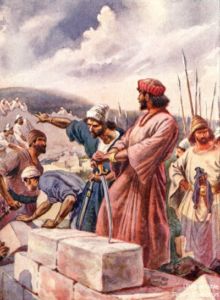Doors & Bolts & Bars in Place: Ethnonationalist Policy in the Bible
Posted By Morris van de Camp On In North American New Right | Comments DisabledAt all the turning points [in Jewish history], it is the more ethnocentric elements — one might term them the radicals — who have determined the direction of the Jewish community and eventually won the day. As recounted in the Books of Ezra and Nehemiah, the Jews who returned to Israel after the Babylonian captivity energetically rid the community of those who had intermarried with the racially impure remnant left behind. Later, during the period of Greek dominance, there was a struggle between the pro-Greek assimilationists and the more committed Jews, who came to be known as Maccabeans. — Kevin B. MacDonald [2]
See also: The Good Book [3] . . . & A Bit More of the Good Book… [4]
Recently I was stuck waiting; the doldrums of waiting for a flight, as well as the doldrums of a hospital waiting room, so I took it upon myself to use the time well by reading the Good Book. I came to realize that the books of Ruth, Ezra, and Nehemiah said quite a bit about ethnonationalism. I found that Nehemiah’s story in particular very much applies to the modern day.
Ruth: The Ethnonationalist Policy of Addition
The Book of Ruth is a political back story. It explains how King David’s Moabite great-grandmother Ruth entered the Israelite community. It is akin to a Northerner explaining his Yankee roots to voters in a Southern state in a local election.
In this book, Naomi is widowed and she and her two daughters-in-law are alone in Moab during a famine. Naomi encourages them to find new husbands among the Moabites while she returns to her family in Bethlehem. The first daughter-in-law, Orpah [5], decides to stay in Moab and find a Moabite husband. The second, Ruth, decides to stay with Naomi and adopt the religion and civic nationalist rituals of Naomi’s Israelite people.
Ruth says to Naomi, “. . . for whither thou goest, I will go; and where thou lodgest, I will lodge: thy people shall be my people, and thy God my God: Where thou diest, will I die, and there will I be buried: the Lord do so to me, and more also, if ought but death part thee and me” Ruth 1:16-17 (KJV). [7]
Ruth and Naomi are in desperate straits. They glean the fields of Naomi’s kinsman-redeemer [8] Boaz to find grain to eat. Naomi encourages Ruth to offer herself in marriage to Boaz to better secure their situation, so Ruth dresses in her best cloths, fixes up her hair, and goes to the threshing floor at night when Boaz is sleeping there and “uncovers his feet [9].” Boaz decides to do the honorable thing and get his family’s permission to marry her. Ruth becomes King David’s great-grandmother.
Ruth’s story is one of ethnonationalist addition. Throughout the Old Testament, the Israelites have terrible problems with the Moabites and Ammonites. However, both tribes are related to the Israelites. The Israelites descend from Abraham and Sarah; the Moabites and Ammonites descend from Abraham’s nephew Lot [11] through his two daughters. All descend from Terah [12].
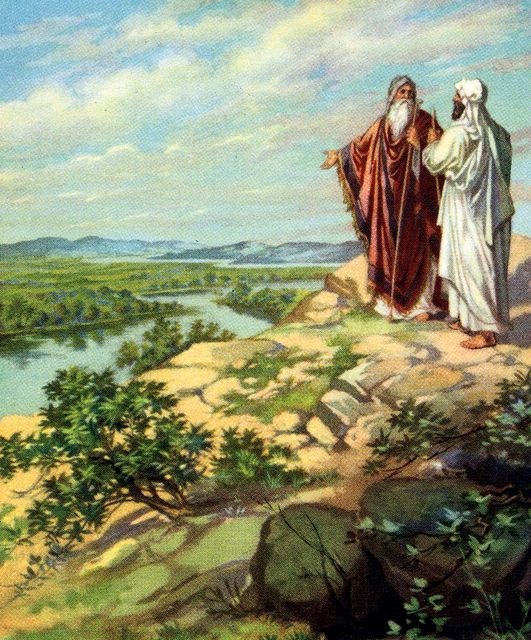 [13]
[13]Abraham and Lot part ways. By their own account, the Moabites, Israelites, and Ammonites were related.
Part of the way that a nation rises to international greatness is to first unite what can be united. The English united the people of Great Britain. The Spanish united the Christians of Iberia. The Muslims united the Arabs. The Americans united their old-stock Anglo-Saxons with immigrants from Northern and Western Europe into a new race called Nordics just after they conquered the remains of the Spanish Empire and became a global player.
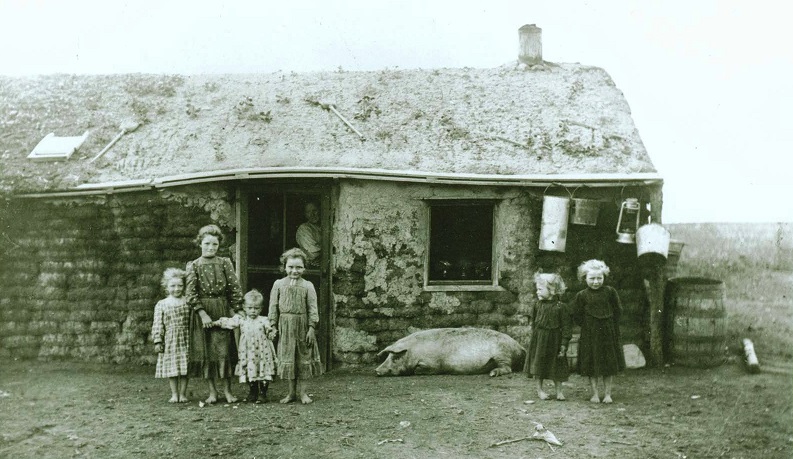 [14]
[14]Uniting what can be united. Russian-Germans in their sod house. The Russian-Germans were not much different from the Pennsylvania Dutch, who were not much different from their Anglo and Welsh Quaker neighbors.
It is possible that with this story, the Israelites could have united the tribes descended from Terah and become a great power. The previous conflicts between Israelites, Moabites, and Ammonites could have been chalked up to a damn good scrap, such as how the Civil War in America was perceived in the 1950s and ‘60s. All could have moved on afterwards. Since Naomi’s two Israelite sons had married Moabites and Ruth went on to marry a second Israelite, it is clear that it was certainly possible for a “children of Terah policy” to have developed then.
Events were out of the Israelites’ control, however. The Egyptians, Babylonians, and Persians were the great powers, and their rivalries affected the Israelites. Israelite internal problems also played a part. The Kingdom of Israel split into two factions: the new, northern Kingdom of Israel sought to unite what could not be united — such as the Israelites with the Phoenicians — as shown in the story of King Ahab. When a government seeks to unite what cannot be united, trouble always follows. Americans, for example, have sought to unite Nordics with sub-Saharans, and since then wars aren’t won and the economy bumbles along with outsourcing and opium problems. Today, America’s domestic politics are unstable. For their part, the Assyrians eventually conquered the northern Kingdom of Israel.
 [15]
[15]Uniting what cannot be united. Sub-Saharans arrested for rioting. America’s domestic politics became unstable after the 1964 Civil Rights Act.
The Kingdom of Judea continued until Jerusalem was conquered and destroyed by Babylon. The story of Babylon’s conquest is found in several books: Jeremiah, Lamentations, and Daniel, among others. The prophet Ezekiel, for example, carries out his ministry by the waters of Babylon. Eventually the Babylonians are conquered by the Persians, and the Persians decide to allow the captives to return to their native lands. This policy probably had an element of Persian domestic politics: It is clear that there were tensions between the exiles and the Persians in the rivalry between Mordechai [16] and Haman [17] as described in The Book of Esther [18]. Once back in Judea, the captives didn’t integrate with the Israelites who remained after the Babylonian conquest; they separated entirely from them.
The Ethnonationalist Policy of Subtraction
To put this in an American context, it would be as though the Irish were to conquer Washington, DC and take all the Americans from that city who descend both from Mayflower passengers and from congressmen, senators, and other officials. These exiles are then sent to work in the mayor’s office in Dublin. In Ireland, these Americans are subjected to tortures and indignities such as being thrown in the lion’s cage at the Dublin Zoo, to the delight of drunken Irish revilers. All of these indignities harden the resolve of the captives and make them more and more American.
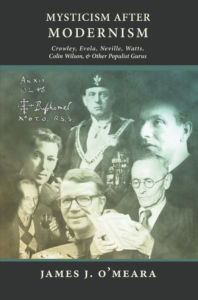 [19]
[19]You can buy James J. O’Meara’s Mysticism After Modernism here [20].
Then one day the French come along and conquer Ireland, and the captives begin working for the French. The French Emperor decides to allow the Americans to return to Washington. When they do so, they find that the Americans who remained are not as pure in their Americanism as the returnees think they should be. To the returnees, the Virginians who started as Jamestown colonists have become a foreign people, and the Pennsylvania Dutch’s unique religious practices are considered abhorrent abominations. The returnees decide to reject all Americans who are not descended from Mayflower passengers and the social elite who were taken into captivity.
The Biblical Prophet who inaugurates this process is Ezekiel. His story begins when Ezekiel has a vision while consulting an astrological chart [21]. He is compelled by God to minister to his people only and keep the community intact. Ezekiel 3:5-6 (KJV) [22] states, “For thou art not sent to a people of a strange speech and of an hard language, but to the house of Israel; Not to many people of a strange speech and of an hard language, whose words thou canst not understand. Surely, had I sent thee to them, they would have hearkened unto thee.”
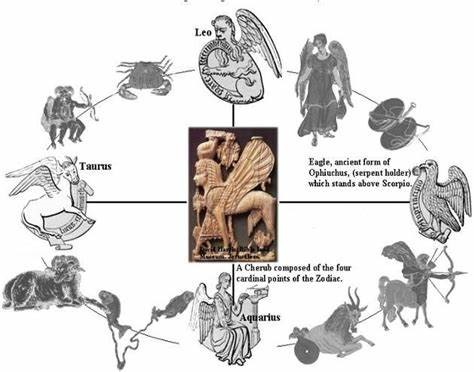 [23]
[23]And every one had four faces: the first face was the face of a cherub, and the second face was the face of a man, and the third the face of a lion, and the fourth the face of an eagle. Ezekiel 10:14 (KJV) [24]
Subtraction, the Jewish Question, & National Self-Defense
As mentioned above, when the captives return to Jerusalem they feel completely separated from the Israelites who stayed behind. What happens next is told in the books of Ezra and Nehemiah. In the former [25], the Priest Ezra and a royal descendant named Zerubbabel goes about rebuilding the Temple using Persian funding and support. Ezra and Zerubbabel secure passports and get a charter to draw upon Persian resources before any ground is broken in Jerusalem.
The Israelites who stayed behind attempt to take part in the project. They had been conducting sacrifices in the ruins of the First Temple. Ezra and Zerubbabel exclude them. The Bible states:
Then [the Israelites who stayed] came to Zerubbabel, and to the chief of the fathers, and said unto them, Let us build with you: for we seek your God, as ye do; and we do sacrifice unto him since the days of Esarhaddon king of Assur, which brought us up hither. But Zerubbabel, and Jeshua, and the rest of the chief of the fathers of Israel, said unto them, Ye have nothing to do with us to build a house unto our God; but we ourselves together will build unto the Lord God of Israel, as king Cyrus the king of Persia hath commanded us. Then the people of the land weakened the hands of the people of Judah, and troubled them in building, and hired counsellors against them, to frustrate their purpose, all the days of Cyrus king of Persia, even until the reign of Darius king of Persia.” Ezra 4:2-5 (KJV) [26]
There is a dark edge to The Book of Ezra. It shows the exact moment when Israelites become Jews — a self-contained people who are utterly hostile to those around them. The Israelites who are unable to join the returnee’s community become Samaritans, Hellenistic supporters after the Greek conquest, and eventually Palestinians.
The local people’s main argument against the rebuilding of the Temple is that the Jews of Jerusalem had a history of troublemaking in the region. Ezra 4:15 (KJV) [26] expresses their concerns. The Samaritans/Locals/”Palestinians” argue,
That search may be made in the book of the records of [the Persian and Babylonian Archives]: so shalt thou find in the book of the records, and know that this city is a rebellious city, and hurtful unto kings and provinces, and that they have moved sedition within the same of old time: for which cause was this city destroyed.
Those opposing the rebuilding of Jerusalem were not wrong. The Jews didn’t revolt against the Persians however, but they did revolt against the Greeks and Romans later.
The separation between the Jews accelerates with Ezra’s marriage policy. Ezra becomes alarmed when the returnees start to take wives from the locals. The Bible says:
“And Ezra the priest stood up, and said unto them, Ye have transgressed, and have taken strange wives, to increase the trespass of Israel. Now therefore make confession unto the Lord God of your fathers, and do his pleasure: and separate yourselves from the people of the land, and from the strange wives. Ezra 10:10-11 (KJV) [27]
Ezra is conducting a policy of extreme ethnonationalist subtraction. The Jews could have set themselves up as an elite and carried out a policy of national reunification such as occurred in Germany and Italy in the 1870s. Lombards, for example, could marry Sicilians if they wanted, and Prussians could marry Bavarians.
The books of Ezra and Nehemiah have some chronological loopholes. It is uncertain who returned first and in what order events unfolded. Most scholars think that the complete rebuilding of Jerusalem took place over several decades, since more than one Persian king is named in both books.
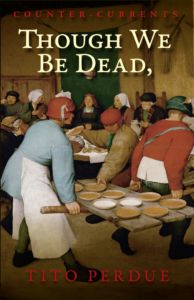 [28]
[28]You can buy Tito Perdue’s Though We Be Dead Yet Our Day Will Come here [29].
In the Book of Nehemiah, the focus is on rebuilding the walls of Jerusalem. Much of the Evangelical Protestant literature on the book has made the story into an allegory of “rebuilding one’s life” after prayer and coming up with a plan. What the Bible describes however, is a real wall is being built. The purpose of the wall is to secure one group of people against another.
Walls that keep people in or out have a deep social and political meaning. During the Trump administration, the border wall was a political rejection of the 1960s social narrative. The politicians who fought tooth-and-claw against building the wall were all supporters of “civil rights.” Implied in Trump’s win-with-the-wall policy is the ability to win on all matters important to whites. A future politician can win with a message of repatriating sub-Saharans, pulling our troops from South Korea, or giving less money to Israel. The political stakes are high with a wall, indeed. The Bible says:
When Sanballat the Horonite, and Tobiah the servant, the Ammonite, heard of it, it grieved them exceedingly that there was come a man to seek the welfare of the children of Israel. Nehemiah 2:10 KVJ [30]
When one reads further into Nehemiah and reflects upon the politics of Trump’s wall, one will notice considerable overlap. The Bible says:
But it came to pass, that when Sanballat heard that we builded the wall, he was wroth, and took great indignation, and mocked the Jews. And he spake before his brethren and the army of Samaria, and said, What do these feeble Jews? Will they fortify themselves? Will they sacrifice? Will they make an end in a day? Will they revive the stones out of the heaps of the rubbish which are burned? Now Tobiah the Ammonite was by him, and he said, Even that which they build, if a fox go up, he shall even break down their stone wall. Nehemiah 4:1-3 (KJV)
As Trump’s wall was being proposed, nobody said that a fox [31] could break down the wall, but many said that such a wall wouldn’t work. “Build a twenty foot wall, and illegals would show up with twenty one foot ladders [32],” was one such quip. It is clear, though, that Trump and his wall did matter. Immigration fell during Trump’s presidency, and after he was usurped by Senile Joe, a border crisis followed. Walls matter, but more important is the government policy of manning the walls to keep out trouble.
Once the threat to the builders becomes clear, Nehemiah orders the workmen to arm themselves:
And it came to pass from that time forth, that the half of my servants wrought in the work, and the other half of them held both the spears, the shields, and the bows, and the habergeons [33]; and the rulers were behind all the house of Judah. Nehemiah 4:16 (KJV) [34]
The names of those who built the wall are enshrined in the Book of Nehemiah. For example, “But the fish gate did the sons of Hassenaah build, who also laid the beams thereof, and set up the doors thereof, the locks thereof, and the bars thereof” Nehemiah 3:3 (KJV) [35] Nehemiah’s wall was finished in 52 days.
Ezra & Nehemiah’s Dark Edge
There is a dark edge to this. Ezra shows the moment when Israelites become Jews. Before Ezra, there is intermarriage with similar tribes, as seen in the Book of Ruth; after Ezra the Israelite political elite wall themselves off from their cousins who were not taken into captivity. Ezra makes the captives/returnees into a people who dwell alone.
Additionally, one sees the in-group/out-group ethics develop in Nehemiah 5 [36]. There, one sees how debt is managed. The debts between Jews are extinguished through various means, but writing off debt always means that someone else takes the loss. The logic of forgiving debt to one’s own means that predatory lending to others becomes a temptation.
Throughout Ezra and Nehemiah we see that the captives/returnees have considerable support from the Persian Empire, but it is uncertain how the Jews help the Persians. Throughout this time, the Persian Empire is on a collision course with the Greeks, but there is nothing in the Bible about Jews in Jerusalem helping the Persians in any strategic sense. The parallels in the relationship between the America that pays Israel and gets nothing worthwhile in return is obvious.
Marriage
Marriage is a two-edged sword of social policy. On the one hand, it can unite people and it works for as long as those people can genuinely be united. In America, many people who were from different nations united by means of intermarriage. Welsh mixed with English and Germans, for example. There was no social stigma attached to this and it helped to create a unified body of whites. However, uniting that which cannot be united is a major problem. Currently, there is an enormous marketing campaign to unite black men with white women. These marriages are known to be unstable and the resulting offspring have all sorts of problems. All the half-Koreans that I’ve known have failed to be successful socially or professionally.
One thing I’ve noticed is that as people get older, they not only move to the Right politically, but their identity becomes more important. Women in particular tend to loudly support “civil rights” when young, but then start to quietly distance themselves from liberal and “civil rights” issues and move to the Right. This is not true of everybody, but I’ve seen it enough times that it feels like a trend.
In picking a marital partner, it is best to marry someone as close to you as possible. As one gets older, you’ll both become more conscious of your respective identities. It is especially important when one raises children. It cuts down on the tension of what church to join or where to draw the line in terms what the children are allowed to do or not do.
Ruth and Ezra have contradictory views on marriage. It is clear that Ruth and Boaz are still carefully entering into marriage, however. Boaz is clearly older than Ruth, and in a high social position as a Kinsman-Redeemer. He was probably married before, although the Bible doesn’t mention a previous relationship. Boaz therefore knows how marriage works. While Ruth is culturally different from Boaz, she is not too much so; Israelites and Moabites both descend from Terah. Ruth has clearly been approved for marriage by her mother-in-law Ruth, who is a female relative of Boaz. Ruth and Boaz were able to get along.
Ezra recognizes that marriage is a tricky business. You don’t just marry a woman, you marry her entire family. Ezra takes the extreme view: Marry your own kind and don’t take any risks.
* * *
Counter-Currents has extended special privileges to those who donate $120 or more per year.
- First, donor comments will appear immediately instead of waiting in a moderation queue. (People who abuse this privilege will lose it.)
- Second, donors will have immediate access to all Counter-Currents posts. Non-donors will find that one post a day, five posts a week will be behind a “Paywall” and will be available to the general public after 30 days.
- Third, Paywall members have the ability to edit their comments.
- Fourth, Paywall members can “commission” a yearly article from Counter-Currents. Just send a question that you’d like to have discussed to [email protected] [37]. (Obviously, the topics must be suitable to Counter-Currents and its broader project, as well as the interests and expertise of our writers.)
- Fifth, Paywall members will have access to the Counter-Currents Telegram group.
To get full access to all content behind the paywall, sign up here:
Paywall Gift Subscriptions
 [38]If you are already behind the paywall and want to share the benefits, Counter-Currents also offers paywall gift subscriptions. We need just five things from you:
[38]If you are already behind the paywall and want to share the benefits, Counter-Currents also offers paywall gift subscriptions. We need just five things from you:
- your payment
- the recipient’s name
- the recipient’s email address
- your name
- your email address
To register, just fill out this form and we will walk you through the payment and registration process. There are a number of different payment options.
